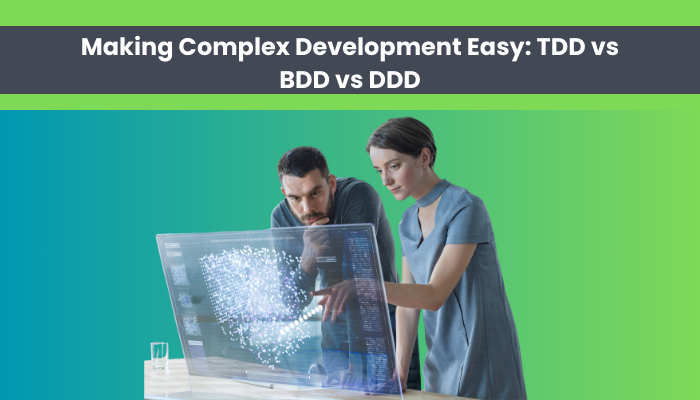
In the world of software development, creating robust, maintainable, and scalable applications is a complex task. To address this challenge, developers have turned to methodologies such as Test-Driven Development (TDD), Behavior-Driven Development (BDD), and Domain-Driven Design (DDD) to streamline the development process.
Each approach offers a unique perspective on how to tackle the complexities of software development. In this article, we will explore and compare these methodologies to provide a comprehensive understanding of their principles, benefits, and potential drawbacks.
Test-Driven Development (TDD)
Definition and Explanation: Test-Driven Development (TDD) is a software development process that relies on the repetition of a very short development cycle: first, the developer writes an automated test case that defines a desired improvement or new function, then produces the minimum amount of code to pass that test, and finally refactors the new code to acceptable standards.
Key Principles:
- Write a failing automated test before writing any production code.
- Write only enough production code to pass the test.
- Refactor the code to improve its structure while keeping all tests passing.
Benefits:
- Encourages writing clean, maintainable code.
- Provides a safety net for refactoring and making changes.
- Promotes a focus on requirements before implementation.
Potential Drawbacks:
- Initial learning curve for developers accustomed to traditional development methods.
- Over-reliance on tests may lead to neglect of overall design.
Real-world Example: The renowned social media platform Twitter has successfully implemented TDD to ensure the reliability and stability of its core functionalities, enabling rapid development and frequent updates.
Behavior-Driven Development (BDD)
Definition and Explanation: Behavior-Driven Development (BDD) is an agile software development process that encourages collaboration between developers, QA, and non-technical or business participants in a software project. It extends TDD by using natural language specifications to define the behavior of a system from the end users’ perspective.
Key Principles:
- Focuses on the behavior of the system rather than implementation details.
- Encourages communication and collaboration between technical and non-technical stakeholders.
- Uses natural language to define requirements and acceptance criteria.
Benefits:
- Improves communication and understanding between different roles in the development process.
- Aligns the development process with business objectives and user needs.
- Provides a clear and shared understanding of system behavior.
Potential Drawbacks:
- Requires active participation and collaboration from all stakeholders, which can be challenging to achieve.
- Writing and maintaining clear, expressive specifications can be time-consuming.
Real-world Example: The popular online retailer Amazon has leveraged BDD to ensure that its e-commerce platform meets the expectations of both users and business stakeholders, resulting in a user-centric and feature-rich shopping experience.
Domain-Driven Design (DDD)
Definition and Explanation: Domain-Driven Design (DDD) is an approach to software development that aims to simplify complex software implementations by focusing on the core domain and domain logic. It provides a set of principles and patterns for making design decisions that prioritize the domain model.
Key Principles:
- Places emphasis on understanding the domain and domain logic.
- Encourages collaboration between technical and domain experts.
- Focuses on creating a domain model that reflects the core business concepts.
Benefits:
- Aligns software design with the complexities of the business domain.
- Promotes a common understanding of the domain model across the development team and domain experts.
- Enables the creation of highly maintainable and adaptable software systems.
Potential Drawbacks:
- Introducing DDD may require a significant shift in the organization’s development culture and mindset.
- Overemphasis on the domain model may lead to overly complex designs.
Real-world Example: Financial institutions like PayPal have successfully applied DDD to model intricate financial domains, resulting in systems that effectively capture complex business rules while remaining flexible and scalable.
Briefly
Test-Driven Development, Behavior-Driven Development, and Domain-Driven Design each offer valuable perspectives and methodologies for simplifying complex software development.
While TDD focuses on code quality and reliability, BDD emphasizes collaboration and user-centric development, and DDD centers around aligning software design with the intricacies of the business domain.
By understanding the principles, benefits, and potential drawbacks of each approach, developers and organizations can make informed decisions to enhance their software development processes and deliver high-quality, user-focused solutions.
By integrating these methodologies, organizations can cultivate a development culture that harnesses the strengths of TDD, BDD, and DDD to tackle the challenges of modern software development, ultimately making complex development easier and more efficient.
Read More Blog You Can Explore this Website – ezine articles.com






